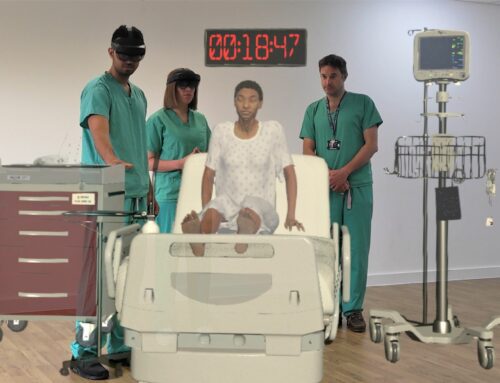By Tammy Graves, Point B
For years, healthcare has talked about embracing a consumer-centric model to deliver on the Quadruple Aim: more effective population health, improved patient experience and quality, provider satisfaction, and lower cost of care. While we’ve all seen fits and starts of progress in pockets around the country, actual change has been too little, too fragmented, and much too slow.
Enter COVID-19. Within months, the explosion in telehealth to safely care for patients during the global pandemic accelerated the pace of change, patient adoption and provider and payer platforms in ways previously unheard of. In response to COVID-19, healthcare organizations not only saw the need – they rushed to meet it, fast-tracking telehealth platforms in record-breaking time. Now, more than six months in, organizations are looking at the long-term implications and opportunities of telehealth and asking, “Where do we go from here?”
Telehealth can be the catalyst to deliver a true consumer-centric model of healthcare for America. The proof points multiply every day, as more providers and patients connect on telehealth platforms. Payers and providers are aligning on its ability to reduce costs and improve care. And life science organizations know telehealth can accelerate important advances, reducing costs and improving the patient experience via remote patient monitoring (RPM) and decentralized clinical trials.
Strategic ways to leverage telehealth
Where to begin? Based on your organization’s current situation, consider two different points of entry: redefine your model of care or redefine the patient/customer experience. Start with the model of care if clinical delivery is your primary focus. Consider the patient customer experience if your north star is consumer centricity.
Redefine your model of care. For provider organizations focused on orienting around clinical delivery, begin by redefining your model of care. Create a customer-centric orientation that considers the future in two to five years. Build your vision on a clear situational analysis of where you are now and what pain points you need to solve for your customers and partners. With this vision in mind, develop the strategy, operating model and roadmap to get there. Create a good governance model and implementation playbook to manage risk along the way.
Redefine the patient/customer experience. If you have a strong consumer-centric orientation, build your telehealth capabilities by first reassessing and redefining the patient/customer experience. The pandemic has probably changed needs and expectations dramatically in just a few months. Based on what you learn, you can redefine your customer experience from their first encounter with your organization through delivery of care. Ultimately, this may lead to strategic changes in your model of care. Consider the example of a payer/provider joint venture that sought to launch a more accessible, customer-centric service platform with integrated call centers, portals, web and mobile channels. This digital-first focus provided a 24/7, differentiated patient experience, creating a high-value interaction while capturing market share and more effective cost of care management.
Make the right moves to mitigate risk
Healthcare organizations face two very different, but very real risks as they consider building telehealth capabilities.
The first risk is waiting – simply saying, “So we’re OK for now. We’ve got a telehealth platform up and running and we’re getting reimbursed for telehealth visits based on today’s waivers and regulations. We can wait and see if the regulatory environment allows for all these telehealth visits going forward.”
While you wait, the industry will quantum-leap past you in ways that make it tough to catch up. If you fail to meet changing expectations and your patients/customers have the ability to go elsewhere, they probably will.
The second risk? Moving too fast, without assessing what your organization really needs. Understandably, in response to COVID-19, many organizations stood up telehealth platforms so rapidly that they bypassed typical planning. Now, many months into the pandemic, it’s time to ask, “What is our vision? What do we aspire to and how does that create value?” and build out a strategic plan to realize it. Without such a vision, you could be “chasing squirrels” for the next five years. The tremendous growth of vendors and startups in this space means there are many bright, shiny objects out there. But if they don’t align to a clear strategy, you could waste a lot of money and end up with a fractured customer experience.
The future: A few frontline observations
Can telehealth really be the driver for a new customer-centric model of care—one that meets new goals of healthcare access, equity and affordability?
The pandemic has forced changes in models of care that have collapsed the work of years into weeks. It’s also evoked the empathy at the heart of healthcare: “How do we best serve our patients and partners? How do we care for people and keep them safe?”
We see a strong desire, and shift, to meet consumers where they are. Now that more providers have gone through the barriers to telehealth adoption, they know they can deliver healthcare in a new way. At the same time, many regulatory and reimbursement barriers have fallen, and it’s unlikely they’ll come up again. The genie is out of the bottle. Patients who have used telehealth are among its biggest fans. The growing volume of positive experiences across all touchpoints is creating a new stickiness. For all these reasons, telehealth will never go back to the periphery of care. It will only become increasingly influential going forward, helping drive a customer-centric model of quality care that’s more accessible and equitable.
COVID-19 accelerated the use of telehealth like nothing else could. In the process, it’s created an opportunity for providers, payers and life science leaders to join forces, raise their voices, and tackle some of the biggest boulders that healthcare has been struggling with for the last 20 years. Take advantage of this moment in time for your consumers – this agile way of thinking and these newfound capabilities. Together, we can make a better healthcare system come true for everyone.
About the author: Tammy Graves is a healthcare consultant with Point B, a consulting company that helps organizations in the areas of customer engagement, growth investments, workforce experience and operations excellence.












